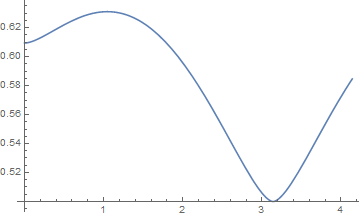I have the following expression
a = 4 Cos[af / 2]^2; b = 1 - 5 Cos[af / 2]^2; c = Cos[af / 2]^2;
s = Sqrt[a*x^4 + b*x^2 + c]
and I need the integration of $s$ in terms of $x$ from $0$ to $1$ to get a function w.r.t. af only, so that I can analyze it and plot it.
I'm using the command
int1 = Simplify[ Integrate[s, {x, 0, 1}] ]
which gives me an error of sth like referencing some memory, I guess it's because it's out of memory?
So I tried int1 = Integrate[s, x] which gives me an expression involving the EllipticF function which I've not heard of, and the simplify command can't give me a simple form. Then I found that int1=0 when x=0, so the integral should equal to
up = int1 /. x -> 1
But this expression still involves the EllipticF function. I wonder if this integration is so complex? It's really out of my expectation, I thought it should be some simple problem that had appeared in the textbook..
Finally, if I have to use a numerical integration instead of symbolic, I wonder how I could plot $s$ w.r.t. $af$ in the range of $af$ in [0, Pi/2]? I tried the command
NIntegrate[s, {x, 0, 1}]
which gives me the error:
the integrand Sqrt[Cos[af/2]^2+x^2 (1-5 Cos[Times[<<2>>]]^2)+4 x^4 \ Cos[af]^2] has evaluated to non-numerical values for all sampling \ points in the region with boundaries {{0,1}}. >>
Then I tried to plot using the function I called "up" (meaning the upper bound)
Plot[up, {af, 0, Pi/2}]
then it gives me a frame without any plot, don't know why.
Could someone help me on simplifying this expression, preferably symbolically, or generate the desired plot numerically?
P.S. The above problem comes from an expression
ww = Cos[t] Sqrt[Sin[af]^2 Sin[t]^2 + 4 Cos[af/2]^4 Cos[2 t]^2]
intw = Integrate[ww, {t, 0, Pi/2}]
So if the latter problem can be solved, the original problem is solved.


